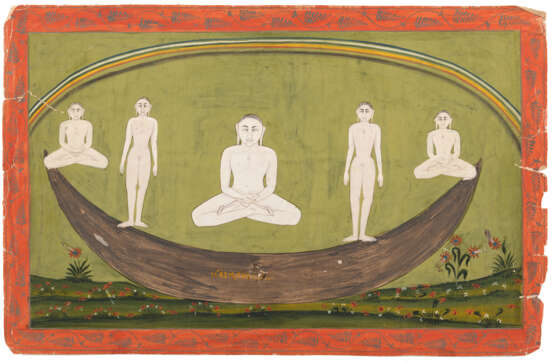ID 972901
Lot 1860 | Zwei Miniaturen: Handabdrücke eines Gottes und Fünf erlöste Jinas
Valeur estimée
€ 600 – 1 000
12 x 7,8 und 27,4 x 42 cm
I: Der Abdruck der Hände von Göttern und Heiligen ist in der religiösen Praxis der Hindus, Buddhisten und Jains gleichermaßen verbreitet. In den hinduistischen Traditionen sind es vor allem die Abdrücke der Hände (Sanskrit: hastakārayantra) des Gottes Viṣṇu, die in der Malerei abgebildet werden. Dabei werden mit der Gottheit assoziierte glücksverheißende Symbole auf dem Handrücken abgebildet. Die hier gezeigten Symbole, u.a. Elefant, Stier, Tempel, Sonne und Mond sowie königliche Banner, lassen sich keiner bestimmten Gottheit zuordnen und haben glücksverheißende Bedeutung in einem eher allgemeinen Sinn. Am unteren Bildrand befindet sich ein Lotusteich, der zusammen mit der blauen Grundfarbe der Hände einen viṣṇuitischen Kontext vermuten lässt. II: Vor einem grünen Hintergrund sind fünf Jinas in sitzender und stehender Haltung abgebildet. Alle Jinas sind unbekleidet, daher steht die Malerei vermutlich im Kontext der Digambara-Richtung des Jainismus, deren Mönche als „Luftbekleidete“ auf Mönchsroben verzichten und nacktgehen. Der sichelförmige Halbmond im unteren Bildabschnitt symbolisiert den Ort der erlösten Seelen (Sanskrit: siddhaloka), der sich der jainistischen Überlieferung zufolge am Scheitelpunkt des Universums befindet. Es handelt sich hier folglich um jene Jinas, die nach ihrem Tod die endgültige Erlösung erlangt haben. Der paradiesische Ort, an dem sie seither verweilen, wird als himmlischer Garten gedacht, was durch die blühenden Pflanzen angedeutet ist.
| Catégorie maison de vente aux enchères: | Art asiatique |
|---|
| Catégorie maison de vente aux enchères: | Art asiatique |
|---|
| Adresse de l'enchère |
Nagel Auktionen GmbH Neckarstrasse 189 - 191 70190 Stuttgart Allemagne | ||||||||||||||
|---|---|---|---|---|---|---|---|---|---|---|---|---|---|---|---|
| Aperçu |
| ||||||||||||||
| Téléphone | +49 (0)711 649 690 | ||||||||||||||
| Fax | +49 (0)711 649 69696 | ||||||||||||||
| Commission | 29,5% | ||||||||||||||
| Conditions d'utilisation | Conditions d'utilisation | ||||||||||||||
| Heures d'ouverture | Heures d'ouverture
|




